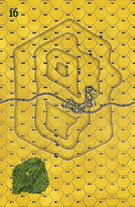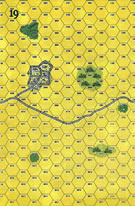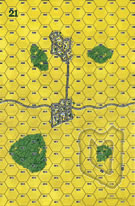|
Stalin's Giants Arctic Front Deluxe #6 |
||
|---|---|---|
| (Defender) Finland | vs | Soviet Union (Attacker) |
| Formations Involved | ||
|---|---|---|
| Finland |  |
5th Infantry Division |
| Soviet Union |  |
20th Heavy Tank Brigade |
| Soviet Union |  |
70th Guards Rifle Division |

| Total | |
|---|---|
| Side 1 | 0 |
| Draw | 0 |
| Side 2 | 1 |
| Overall Rating, 1 vote |
|---|
|
4
|
| Scenario Rank: --- of 913 |
| Parent Game | Arctic Front Deluxe |
|---|---|
| Historicity | Historical |
| Date | 1939-12-17 |
| Start Time | 08:30 |
| Turn Count | 40 |
| Visibility | Day & Night |
| Counters | 95 |
| Net Morale | 1 |
| Net Initiative | 0 |
| Maps | 4: 16, 19, 21, 8 |
| Layout Dimensions | 86 x 56 cm 34 x 22 in |
| Play Bounty | 164 |
| AAR Bounty | 171 |
| Total Plays | 1 |
| Total AARs | 1 |
| Battle Types |
|---|
| Exit the Battle Area |
| Inflict Enemy Casualties |
| Rural Assault |
| Conditions |
|---|
| Entrenchments |
| Off-board Artillery |
| Terrain Mods |
| Scenario Requirements & Playability | |
|---|---|
| Arctic Front Deluxe | Base Game |
| Airborne - IE | Counters |
| Eastern Front | Maps + Counters |
| Road to Berlin | Maps + Counters |
| Introduction |
|---|
|
The Red Army saw the invasion of Finland as an experimental laboratory for new tactics and weapons and in mid-December rushed several prototype tanks to the front for battlefield testing. New heavy tanks had been developed to break through enemy fortified positions, and the Finnish concrete-and-steel bunkers around Summa were exactly what the Red Army had in mind when it asked for the big tanks. The Finns knew the Soviets had gigantic tanks, but all the same did not expect the monsters that came looming out of the mist. |
| Conclusion |
|---|
|
The big tanks made three tries to get past the Finnish positions, but their accompanying infantry could not keep up and their commanders would not risk them where anti-tank squads could approach in stealth. Finnish anti-tank rounds bounced harmlessly off the tanks' thick skins, but a lucky shot snapped off the main gun barrel of one KV and the remaining tanks shepherded their wounded comrade back to the start line. They would try again for two more days, until one of the experimental SMK tanks hit a mine and had to be abandoned inside the Finnish lines. It was recovered in March, but the Red Army had made its choice and the KV became its new standard heavy tank. |
| AFV Rules Pertaining to this Scenario's Order of Battle |
|---|
|
| 1 Errata Item | |
|---|---|

|
The reduced direct fire value in Kursk: Burning Tigers is 4-4. (plloyd1010
on 2015 Jul 31)
|
| Ruptura no, infiltración. | ||||||||||||
|---|---|---|---|---|---|---|---|---|---|---|---|---|
En este escenario una poderosa fuerza soviética compuesta por un regimiento de infantería y una compañía de tanques pesados ataca una bien defendida línea finlandesa. Los soviéticos cuentan con los potentes tanques pesados SMK y KV-1 y el apoyo de una contundente artillería fuera del mapa (3 x 12, 2 x 18, 1 x 24). Los finlandeses despliegan dos batallones de infantería, dos secciones de morteros, tres secciones de cañones AT de 37 mm y una no despreciable artillería fuera del mapa (3 x 8, 1 x 16). Los finlandeses han establecido su línea principal a lo largo de siete posiciones atrincheradas en sentido este-oeste en los mapas 21 y 16. Además, han establecido una segunda línea más débil apoyada en tres posiciones atrincheradas y dos poblaciones. Ambas líneas están reforzadas por seis "puntos fortificados" dotados de ametralladoras. Los defensores se despliegan en las posiciones atrincheradas, con la excepción de una pequeña reserva (una compañía) en una de las poblaciones de retaguardia. Los soviéticos se despliegan en varios grupos a lo largo de todo el frente. La batalla tiene lugar de día, aunque en la primera hora y media la visibilidad es reducida. Los finlandeses tienen mejor moral (8/7). El objetivo de los soviéticos es perforar la línea defensiva enemiga, produciendo el mayor número de bajas posible, y hacer salir a sus unidades por el borde norte del mapa. El objetivo de los finlandeses es impedirlo y producir bajas al atacante. Los soviéticos inician el avance por el borde oeste del mapa con el grupo más numeroso de sus fuerzas. El resto de efectivos se mantiene en sus posiciones. Los soviéticos empiezan a machacar las posiciones atrincheradas enemigas situadas frente a las unidades atacantes. Utilizan potentes concentraciones de fuego de bombardeo (columnas 55 y 30). Los finlandeses sufren las primeras bajas, en especial los cañones AT de 37mm y los "puntos fortificados". No obstante, debido a las buenas posiciones defensivas y a la calidad de sus líderes, las unidades finlandesas de infantería aguantan bien en sus posiciones. El comandante soviético estima que va a ser muy difícil "romper" las posiciones defensivas y hacer un boquete en la línea enemiga, por lo que ordena que sus unidades sobrepasen las posiciones enemigas sin asaltarlas, esto es, infiltrándose. Naturalmente los finlandeses reaccionan con su artillería, morteros y fuego de oportunidad, pero no pueden impedir que una buena parte de unidades atacantes atraviesen sus líneas y avancen hacia la retaguardia. La situación se vuelve crítica para los defensores, que envían a su pequeña reserva a frenar el avance enemigo. Los soviéticos aprovechan su demoledora artillería para bombardear las unidades enemigas que les salen al paso y que han dejado de estar en posiciones protegidas y que por ello sufren bajas. Los finlandeses se ven obligados a retirar fuerzas de las posiciones atrincheradas de primera línea para formar una nueva e improvisada línea defensiva a retaguardia. Este momento es aprovechado por los soviéticos, que ahora lanzan al ataque a dos compañías en el extremo este del campo de batalla. Sin embargo este ataque es frenado en seco por los finlandeses. Los soviéticos sufren pérdidas y deben retirarse al punto de partida. No obstante, el centro de gravedad de la batalla está en el extremo oeste, donde se produce una épica lucha entre la infantería y tanques pesados soviéticos y los finlandeses desplegados apresuradamente en una improvisada y débil línea defensiva. La artillería hace estragos. Las bajas son muy numerosas en ambos bandos. Por fin, los soviéticos consiguen hacer salir del mapa a una compañía y media de infantería y a dos secciones de tanques, pero después los finlandeses consiguen volver a formar una débil línea, que de nuevo detiene a los soviéticos. Los finlandeses mandan nuevas unidades, sacadas de las posiciones atrincheradas, para atacar de flanco a los sovéticos infiltrados. Se producen asaltos en los que los finlandeses llevan ventaja, pero los soviéticos responden con un devastador fuego de artillería. La sangrienta batalla llega a su fin. Los soviéticos consiguen una victoria menor, al obtener 32 VP frente a los 23 VP de los finlandeses. Magnífico escenario del que hay que sacar dos lecciones: 1) Si atacante tiene menos potencia de fuego y moral que el defensor, es inútil lanzar ataques frontales y asaltos. Lo más inteligente es desbordar las posiciones defensivas por infiltración y destruir al enemigo cuando en el contraataque salga de sus posiciones protegidas. 2) Las defensas fijas conceden ventaja al atacante, ya que éste puede elegir el lugar y el momento donde desbordar la línea enemiga. |
||||||||||||
| 0 Comments |

 AFDx005
AFDx005 




























